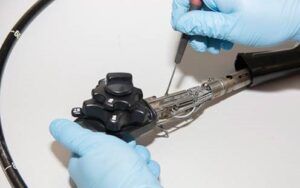 Endoscopes, as flexible instruments that frequently need to be repaired due to wear and tear, often become very difficult to track as they leave and enter the hospital. Managers of Endoscopy and PeriOperative departments may see a constant stream of endoscopes being sent out for repair and loaner scopes being sent back to them for “temporary” use. It is quite often a challenge for Endoscopy departments, especially busy ones, to track their scopes that are sent out for repair with the proper scrutiny.
Endoscopes, as flexible instruments that frequently need to be repaired due to wear and tear, often become very difficult to track as they leave and enter the hospital. Managers of Endoscopy and PeriOperative departments may see a constant stream of endoscopes being sent out for repair and loaner scopes being sent back to them for “temporary” use. It is quite often a challenge for Endoscopy departments, especially busy ones, to track their scopes that are sent out for repair with the proper scrutiny.
Due to poor tracking of scopes out for repair, it is all too common for loaner scopes to become a permanent part of a hospital’s scope fleet – they are hard to track and without proper documentation it is hard to know when they’re due to be sent back to the vendor. They can be a source of unnecessary and frequent charges from your vendors.
Scopes sent back to the vendor for repair are typically fixed over varying and unpredictable time frames, depending on the severity of the damage. The loaner scopes that are sent back to the hospital are intended to be used while the original scope is out for repair. However, what often ends up really happening is that the repaired scope comes back from the manufacturer while the loaner scope remains at the hospital, creating excess inventory. The fees from keeping the loaner scope too long usually begin shortly after the original returns, and without proper oversight the fees from keeping loaner scopes can become significant. Additionally, loaner scopes can, and quite often do, get lost. It may be a temporary or permanent loss of the scopes, but either way if the loaner scope isn’t found when the vendor asks for it, you may get hit with an unexpected bill.
All of the complexities around scopes that go out for repair and the loaner scopes that come in to replace them require a team member to constantly watch over a hospital’s scope inventory. Many hospitals use a spreadsheet to track the scopes as they go in and out, but many others have no system and just hope for the best. However, several hospitals are currently in the market for a system that can better track their scopes both inside and outside of the hospital. Academic medical centers and large health systems especially require a solution due to the sheer number of repair and loaner scopes they have track at any given time.
Thankfully, a system called iRIScope includes a specific module to track scopes as they go out for repair, including the description of the damage, timestamp of when the scope was sent for repair and the time elapsed since the scope left the hospital. A newly released feature also helps hospitals manage their loaner scope inventory. When loaner scopes reach the end of their term, iRIScope can send proactive alerts to notify techs that loaner scopes need to be returned to the vendor. iRIScope tracks the usage levels of loaner scopes so you can make sure you keep loaner scope usage to a minimal level when possible. iRIScope also helps track down missing loaner scopes by recording a real-time chain of custody of scopes so missing scopes can be identified and tracked down immediately. iRIScope helps to mitigate all of the risks associated with loaner scopes as part of its best in class scope tracking capabilities. iRIScope will also help manage all of the usage, reprocessing and repair details of your entire scope inventory, and will offer up actionable analytics on how to improve the management of your expensive scopes. Built in patient safety features also minimize the risk from adverse health events caused by inadequately reprocessed scopes.
